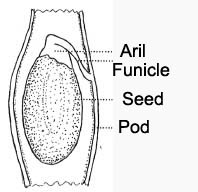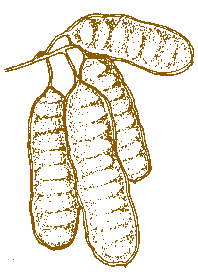Home || Back Issue Contents || Search ||
Issue 4, Oct-Nov 1997
Choosing Acacia Species for Bushtucker
Choosing Acacia Species for Bushtucker
Dr Beth Gott, Hon. Research Associate, Dept. Biological Sciences, Monash University.
There are over 650 species of Acacia (Wattles) in Australia, and in any region it is possible to find a number of local wattle species. Some species are of restricted distribution, such as Cootamundra Wattle, Acacia baileyana, which was originally from a small area of New South Wales but which has spread from cultivation to invade the bush in Victoria. Other species are of very wide occurrence, such as Mulga, A. aneura, characteristic of vast areas of the arid lands.
Wattles had many Aboriginal uses; the inner bark of some species made excellent string, whole bark was fashioned into buckets, the tannin content of bark and leaves was exploited for medicine and fish poison, galls were eaten, the wood was used for implements of all sorts and the Tasmanians hung wattle blossom in their huts to help them sleep. Some species produce edible gums from the trunk and branches, complex polysaccharides which act as fibre in the diet. The seeds of some species are known to have been used as food by Aborigines, but for others there is no record.

As a food resource, they cannot he ignored and it is the seed which is usually the aim of the bushtuckler industry. For production one may have the choice of wild harvesting, but it is more usual for people to consider the establishment of plantations of these quick growing species. The presence of root nodules enables Acacias to flourish in nitrogen poor soils, in a similar way to beans and peas and most species are drought resistant. How then does one choose which of those 700 species to plant? I think it is best to first consider if any of your local species are suitable, since Acacias introduced from other areas can sometimes become weed species in native bushland. Cultivation conditions aside, one then has to decide which seeds will be most acceptable for the bushfood market, and it is here that an examination of the seed characteristics can he helpful.
There is a matter of taste. Raw seed may have an unpleasant lingering sulphurous taste, but this may disappear when the seed is roasted; an example of this is Acacia longifolia variety sophorae, the Coast Wattle. Acacia seeds almost always have a small brown, white or reddish body attached to them known as either an aril/funicle or an eliasome. The aril is a swelling at the seed end of the funicle or stalk w hich attaches the seed to the pod. The stalk can sometimes be quite long and curved around the seed, as in Acacia melanoxylon, Blackwood. The term eliasome refers to the function of the aril/funicle, which is to attract mammals, birds or ants to disperses the seed. This body is of variable size and usually contains proportionally more lipid (oil or fat) - from 13% to 70% - than the seed itself.
One has to consider both the size of the seed and whether large amounts are borne. Acacia ligulata, Small Cooha, bears quite large seeds while Acacia dealbata, Silver Wattle, has relatively small seed, about 1/3 the size. Small size may be compensated by the production of large numbers of seed. Some reference books contain scaled drawings of seeds (Tame 1992. Whitby 1980). There is also the question of how easily the seed can be harvested. Some wattles will open their pods and retain the seed in the pod - they rely on birds to disperse the seed, and the aril, or seed attachment, is often brightly colored to attract the birds.
An example of this is Acacia melanoxylon, Blackwood. Other wattles open their pods and the seed falls to the ground, and is dispersed by ants. For these wattles it should be possible to pick the pods when the seed is fully swollen but still green, and allow the seeds to dry and harden, for example Acacia pycnantha, Golden Wattle, and Acacia myrtifolia, Myrtle Wattle.
Some species have woody pods from which it is difficult to remove the seed. A good example is Acacia stenophylla, Eumong or River Cooba. The pods are long, like strings of beads, and can break up between seeds. The woody pod is difficult to open when dry but Aborigines nevertheless ate the seeds, possibly while the pods were still green, or by using fire to open the pods.
The lipid content of both the seed and its attachment will determine whether the seed can be dry roasted. The aril will readily yield up its lipid when heated. It the aril is large, this will indicate a relatively high fat content overall.
Table 1 gives the relative size and lipid content of seeds and arils of some selected species. The data is taken from a list of 93 species in O'Dowd & Gill (1986, 92-95). Similar information unfortunatelv does not exist for all Acacia species. Haemagglutinin in the seed is potentially poisonous. Although not all species have been tested, the general opinion is that no Australian species of acacia contain haemagglutinins or harmful levels of other anti-nutritional factors. (Toms & Western 1971, 435; Korrt, A.A. 1985, 132).
The use of Acacia leaves or bark for fish poisons is probably due to tannin, which is astringent but not poisonous. However, the bark stem and leaves of some species have been found to contain alkaloids (Collins et al. 1990.49-52). The gums are bland tasting and soluble in water. Aborigines in Victoria deliberately notched the trees to produce a flow of gum.With the above points in mind, let us look at some southeast Australian Acacias which might be potential seed producers.
Acacia implexa, Lightwood, a small tree, widely spread, has a moderate sized seed, a large aril with a high fat content, and probably retains its seed.
Acacia ligulata, Small Cooba, shrubby, is known to have been an Aboriginal food. It has a wide range in arid Australia, a large seed, retained in the pod, and a large aril with a high fat content. It suckers freely.
Acacia longifolia var. sophorae, Coast Wattle, previously Acacia sophorae, now regarded as variety sophorae of Acacia Longifolia, the Sydney Golden Wattle, meets many of the criteria.
When roasted, the seed has a pleasant nutty flavor, the seeds are reasonably large, and are retained in the pod. They are known to have been used by Aborigines. The aril is large, with a high fat content. In some places in Victoria Acacia longifolia variety longifolia is regarded as an invader of bushland, though in places near the coast the two varieties seem to blend into one another and the seeds are very similar.
Planting of variety longifolia would seem to be inadvisable except where it occurs naturally.
Acacia melanoxylon, the Blackwood tree, it retains its seed, and often produces large amounts but both the seed and aril are low in fat.
Acacia myrtifolia, Myrtle Wattle, is a small shrub, variable, very widespread. The seeds are small, but with a very high lipid content (19%).
Acacia penninervis. Hickory Wattle, has a large seed, held in the pod. with 11% lipid. The aril is of moderate size, 38% lipid.
Acacia salicina. Willow Wattle, is a small tree, closely related to A. liguluta, with similar characteristics, but the pods are woody. Woody pods may well be a drawback.
Acacia verniciflua, Varnish Wattle, was used by the Tasmanians.
It probably sheds its seed, as does Acacia pycnantha, Golden Wattle, the seeds of which are of moderate size, 15% lipid,aril small- about l/10th weight of seed, 42% lipid.
Since there are so many species of wattle, we lack information about a lot of them, but you can see that there is a good deal of room for experiment. As far as we know, none of the Acacia seeds contain deleterious substances, so taste is probably a good guide to use.
References:
Collins. D.J. et al. 1990 Plants for medicines - a chemical and pharmacological survey of plants in the Australian region. CSIRO, Australia.
Korrt, A.A. 1985 Characteristics of the Proieinase Inhibitors of Acacia Seeds. In Jones, G.P. (ed) The Food Potential of Seeds from Australian Native Plants. Deakin Ljniversity Press, Victoria.
Miller, J. Brand, K.W. James, & P.M.A. Maggiore 1993 Tables of Composition of Australian Aboriginal Foods. Aboriginal Studies Press, Canberra.
O'Dowd, D & Gill, A.M. 1986 Seed Dispersal Syndromes in Australian Acacia, in D. Murray (ed.) Seed Dispersal, p. 87-121.
Tame, T. 1992 Acacias of Southeast Australia. Kangaroo Press, Kenthurst. NSW.
Toms, G.C. & Western. A. 1971 Phytohaemagglutinins. In J. B. Harborne et al. (eds) Chemotoxonomy of the Leguminosae. Academic Press, London.
Whitby, D.J.E. 1980 Acacias of South Australia. Government Printer, S.A.
Inhibitors of Acacia Seeds. In Jones, G.P. (ed) The Food Potential of Seeds from Australian Native Plants. Deakin University Press, Vic
Dr. Beth Gott is a botanist who has specialised in the use of plants by the Aborigines of South eastern Australia. She has prepared extensive databases for Victoria, NSW, Tasmania and the higher rainfall areas of South Australia. She also studies Aboriginal land management. She has co-authored two books: 'Victorian Koorie Plants' and 'Koorie Plants, Koorie People', as well as various papers on Aboriginal plant use.
Choosing Acacia Species for Bushtucker
The Southern Bushfoods Association
Acacia ~ research, field trials and databases
Extracts from 'The Bushfoods Handbook' - Vic Cherikoff
Bush Foods in History Series 3 - honey from native bees
Notes: Acacia - John Mason
Tucker & Timber: Integrating Bushfoods
Bush food plants of western Queensland
Bunyas and the whole farm plan - John King
Products & People: Basically Wild Edible Art
Protecting New Bushfood Varieties